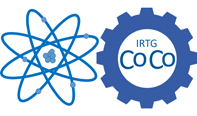11.02.20 - Nicolas Sisourat "Interatomic Coulombic Decay in mixed helium clusters"
Nicolas Sisourat, Laboratoire Chimie Physique Matière et Rayonnement, Sorbonne Université, Paris, France
| When |
Feb 11, 2020
from 01:00 PM to 02:00 PM |
|---|---|
| Where | HS II, Physical High Rise |
| Contact Name | Simone Ortolf |
| Contact Phone | 203-97666 |
| Add event to calendar |
|
Interatomic Coulombic Decay in mixed helium clusters
Interatomic Coulombic Decay (ICD) is an efficient energy transfer between atoms and molecules. Via ICD, the excess energy of a donor species is transferred to a neighboring acceptor systems which is thus ionized. ICD is a general mechanism, observed in many systems and have a central role in radiation damage as well as in spectroscopical analysis. After a general introduction on ICD and how to compute its properties from first principles, I will present the results of 2 recent studies of ICD in mixed helium clusters: In the first example, ICD is explored in excited metal-doped He nanodroplets. We have shown that the long-range and the short-range contributions to ICD can be clearly distinguished experimentally and that ICD is largely dominated by charge exchange process even at large interatomic distances. In the second example, I will report on ICD induced molecular bond-breaking. It will be shown that dissociation of a molecule can be efficiently achieved via ICD. On the example of the giant He-H2 dimer, we show that simultaneous ionization and excitation of the helium atom induces H2 dissociation with a high probability.
Interatomic Coulombic Decay (ICD) is an efficient energy transfer between atoms and molecules. Via ICD, the excess energy of a donor species is transferred to a neighboring acceptor systems which is thus ionized. ICD is a general mechanism, observed in many systems and have a central role in radiation damage as well as in spectroscopical analysis. After a general introduction on ICD and how to compute its properties from first principles, I will present the results of 2 recent studies of ICD in mixed helium clusters: In the first example, ICD is explored in excited metal-doped He nanodroplets. We have shown that the long-range and the short-range contributions to ICD can be clearly distinguished experimentally and that ICD is largely dominated by charge exchange process even at large interatomic distances. In the second example, I will report on ICD induced molecular bond-breaking. It will be shown that dissociation of a molecule can be efficiently achieved via ICD. On the example of the giant He-H2 dimer, we show that simultaneous ionization and excitation of the helium atom induces H2 dissociation with a high probability.
Filed under:
SeminarSeries


